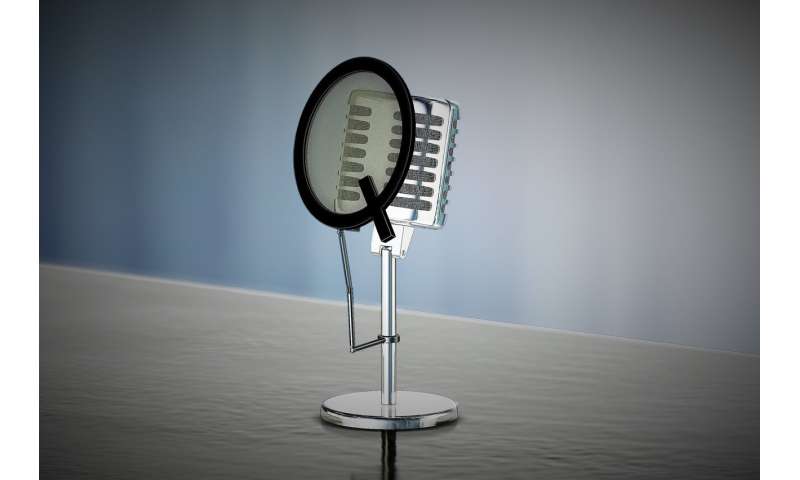Quantum microphone lets humans hear the advantage of quantum technologies

Online conferences have become essential to work. However, these meetings become annoying if the audio quality is noisy due to poor performance of the microphones. This is also the daily experience of hearing aid or cochlear implant users, who have to struggle with a poor signal-to-noise ratio in noisy environments.
To address this issue, engineers developing commercial microphones focus on eliminating technical sources of noise, such as that found in the signal amplifiers.
But even when the technical noise sources are addressed, there is still a fundamental noise stemming from the quantum nature of any measurement.
For high-sensitivity microphones that can perform close to this fundamental noise level, laser-based devices are top candidates. They measure the slightest displacements of microphone membranes in a fashion that resembles a microscopic version of gravitational wave interferometers. Such devices are currently being used for measuring wear in industrial machines, as well as in espionage.
Beating the performance of a laser microphone
Entangled photons can make use of quantum correlations to measure small displacements with an improved signal-to-noise ratio compared to laser light. However, the generally complex experimental setting of quantum physics experiments leads to a tremendous resource overhead and complicated data processing, which results in measurement rates of a few data points per second, at most. This is obviously incompatible with recording sound, where at least tens of thousands of data points per second need to be recorded to reconstruct the waveform.
In our study published in PRX Quantum, we found a new method that combines several fundamental quantum optics concepts to realize a quantum optical displacement sensor that is simple, robust, and operates below the classical noise limit at sampling rates up to 100 kHz.
If you are like most physicists, you would now sit down on your desk, write a paper about your quantum displacement sensor, and then call it a day.
But we wanted to show that this high measurement rate can actually be useful. Thus, we used a loudspeaker, placed it in front of our membrane, and then played 26,400 words from a medically approved speech recognition test. We then recorded the membrane displacements with a classical laser sensor and with our quantum optical sensor. Unsurprisingly, the data revealed that the signal-to-noise ratio was improved using quantum light.
However, we wanted to go even further. Thus, we went to our local hospital, which also hosts a research department, including a calibrated sound studio environment. There, we used the recorded words to conduct a speech recognition test on 45 patients, which turned out to be quite a challenge during the COVID crisis. Nevertheless, our data showed that more than 71% of the subjects were able to hear the improvement provided by the quantum microphone. On average, our patients understood words correctly at a 0.57 dB reduced sound pressure level.
In other words, humans were able to hear the quantum advantage for the first time.
What's next? We are now developing a compact version of our experiment to present it at conferences and exhibitions, thus allowing more people to listen to the sound quality produced by the quantum microphone. Additionally, we see a great potential of our technique in the framework of imaging of light-sensitive bio-samples. Here, it is crucial to use as little light as possible to obtain a sharp image. In the appendix of our work, we have showed that commercially available improvements on our scheme can realistically make it a competitor for classical bio-imaging techniques.
We find ourselves in a time when the combination of quantum optics and quantum sensing promise exciting developments in the 21st century: the century of the photon.
This story is part of Science X Dialog, where researchers can report findings from their published research articles. Visit this page for information about ScienceX Dialog and how to participate.
More information: Raphael Nold et al, Quantum Optical Microphone in the Audio Band, PRX Quantum (2022). DOI: 10.1103/PRXQuantum.3.020358 , journals.aps.org/prxquantum/ab … /PRXQuantum.3.020358
Avalable on Arxiv: doi.org/10.48550/arXiv.2204.12429
Florian Kaiser studied Physics at Stuttgart University (Germany). He obtained his PhD degree in 2012 from Université Nice Sophia Antipolis (France, Tanzilli group) for his work on fiber-based quantum networks with entangled photon pairs. In 2013, he obtained the Thesis Prize of the European Physical Society. After a one-year stay at the DESY in Hamburg (Germany), he returned as a PostDoc to France, where he developed quantum frequency converters and high-accuracy quantum optical sensors. Since 2017, he is a permanent researcher and group leader in the team of Jörg Wrachtrup (Stuttgart). He set up a team of 10-15 young students who are devoted to the development of quantum technologies. His main interests are nanophotonic integration of SiC color centers in the perspective of quantum networking/computing, as well as quantum optical sensing based on entangled photons.